Related Research Articles

The Philippine Scouts (Filipino: Maghahanap ng Pilipinas/Hukbong Maghahanap ng Pilipinas) was a military organization of the United States Army from 1901 until after the end of World War II. These troops were generally Filipinos and Filipino-Americans assigned to the United States Army Philippine Department, under the command of American commissioned officers (though a handful of Filipino Americans received commissions from the United States Military Academy). Philippine Scout units were given the suffix "(PS)", to distinguish them from other U.S. Army units.
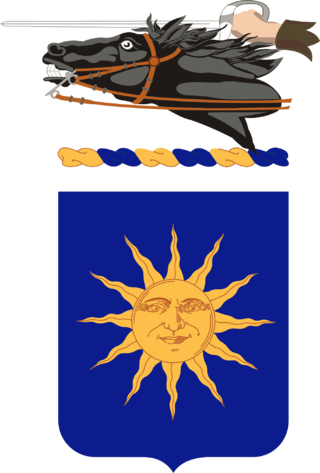
The 26th Cavalry Regiment (Philippine Scouts) (26th CAV (PS)) was part of U.S. Army Forces Far East's Philippine Department, during World War II. The 26th engaged in the last cavalry charge in the history of the U.S. cavalry. The American Battle Monuments Commission list 301 dead who were members of this regiment interred at Manila American Cemetery and Memorial.

The Hukbong Bayan Laban sa Hapon, better known by the acronym Hukbalahap, was a Filipino communist guerrilla movement formed by the farmers of Central Luzon. They were originally formed to fight the Japanese, but extended their fight into a rebellion against the Philippine government, known as the Hukbalahap rebellion in 1946. It was eventually put down through a series of reforms and military victories by Defense Secretary, and later President, Ramon Magsaysay.

The Battle of Bataan was fought by the United States and the Philippine Commonwealth against Imperial Japan during World War II. The battle represented the most intense phase of the Japanese invasion of the Philippines during World War II. In January 1942, forces of the Imperial Japanese Army and Navy invaded Luzon along with several islands in the Philippine Archipelago after the bombing of the American naval base at Pearl Harbor.
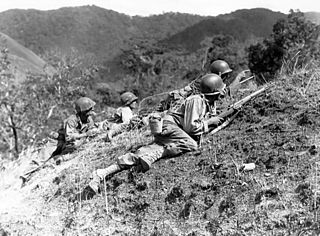
The Battle of Luzon was a land battle of the Pacific Theater of Operations of World War II by the Allied forces of the U.S., its colony the Philippines, Mexico, and allies against forces of the Empire of Japan. The battle resulted in a U.S. and Filipino victory. The Allies had taken control of all strategically and economically important locations of Luzon by March 1945, although pockets of Japanese resistance held out in the mountains until the unconditional surrender of Japan. While not the highest in U.S. casualties, it is the highest net casualty battle U.S. forces fought in World War II, with 192,000 to 217,000 Japanese combatants dead, 8,000 American combatants killed, and over 150,000 Filipinos, overwhelmingly civilians who were murdered by Japanese forces, mainly during the Manila massacre of February 1945.

Keith Andes was an American actor. He is known for films such as Blackbeard the Pirate (1952) and Clash by Night (1952).
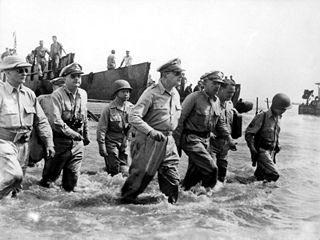
The Philippines campaign, Battle of the Philippines, Second Philippines campaign, or the Liberation of the Philippines, codenamed Operation Musketeer I, II, and III, was the American, Filipino, Australian, and Mexican campaign to defeat and expel the Imperial Japanese forces occupying the Philippines during World War II.
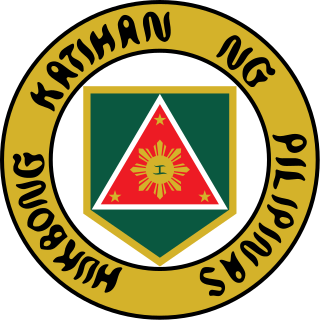
The Philippine Army (PA) is the main, oldest and largest branch of the Armed Forces of the Philippines (AFP), responsible for ground warfare and as of 2021 had an estimated strength of 143,100 soldiers The service branch was established on December 21, 1935, as the Philippine Commonwealth Army. The Philippine Army has engaged in many conflicts including the ongoing Communist rebellion in the Philippines, the Moro conflict and, alongside other national military forces, in conflicts of international scope.

Robert Lapham was a reserve lieutenant in the US Army in World War II. He served in the Philippines attached to the 45th Infantry, evaded capture in the spring of 1942, and organized and led one of the largest and most successful guerrilla armies on the central plains of the northern island of Luzon. He was promoted to major by war's end, age 28, and was awarded the Distinguished Service Cross by General Douglas MacArthur. Lapham was the third person, after President Franklin Delano Roosevelt and MacArthur, to receive the Philippine Legion of Honor. Historian Norling says that Laphams's Luzon Guerrilla Army Force (LGAF) was probably the most efficient of the many guerrilla armies on Luzon. The U.S. Guerrilla Affairs Division commended Lapham for having the best-disciplined guerrilla organization.

The Japanese occupation of the Philippines occurred between 1942 and 1945, when the Japanese Empire occupied the Commonwealth of the Philippines during World War II.
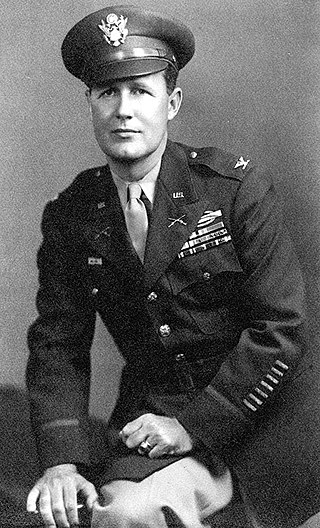
Brigadier General Donald Dunwody Blackburn was a United States Army Special Forces officer, best known for his significant command and developmental roles in the U.S. Army Special Forces. He was also the commander of the highly classified Studies and Observations Group from 1965 to 1966.

Eulogio Balauitan Balao was a Filipino soldier and politician.

Russell William Volckmann was a graduate of the United States Military Academy at West Point, a U.S. Army infantry officer and a leader of the Philippine Commonwealth military and guerrilla resistance to the Japanese conquest of the Philippines during World War II. After the war, he remained in the U.S. Army and helped create the U.S. Army Special Forces. Volckmann, together with Colonels Aaron Bank and Wendell Fertig are considered the founders of the U.S. Army Special Forces. He eventually retired as a brigadier general.
The Hunters ROTC was a Filipino resistance group that fought against Axis forces in the Pacific theater. It was a guerrilla unit active during the Japanese occupation of the Philippines, and was the main anti-Japanese resistance group active in the area near Manila, the capital of the Philippines. It was created upon the dissolution of the Philippine Military Academy.
Ray C. Hunt was a staff sergeant in the United States Army Air Forces stationed at Nichols Field in the Philippines at the beginning of World War II, under the command of Ed Dyess. After the surrender at Bataan, where he fought as an infantryman, he was forced to take the Bataan Death March with many other American and Filipinos. During the March, he escaped and fled into the hills. He eventually became a noted guerrilla leader on Luzon, where he served for three years behind Japanese lines. Hunt was promoted to captain by guerrilla leaders during that time.

During the Japanese occupation of the islands in World War II, there was an extensive Philippine resistance movement, which opposed the Japanese and their collaborators with active underground and guerrilla activity that increased over the years. Fighting the guerrillas – apart from the Japanese regular forces – were a Japanese-formed Bureau of Constabulary, the Kenpeitai, and the Makapili. Postwar studies estimate that around 260,000 people were organized under guerrilla groups and that members of anti-Japanese underground organizations were more numerous. Such was their effectiveness that by the end of World War II, Japan controlled only twelve of the forty-eight provinces.
The United States Army Forces in the Philippines – Northern Luzon or United States Armed Forces in the Philippines – Northern Luzon (USAFIP-NL) was the military and guerrilla organization active in the Philippines after the Japanese occupation. It was made up of United States Army and Philippine Army soldiers, reservists and civilian volunteers.
The Battle of Mayoyao Ridge was part of the Philippines campaign of 1944–1945 during World War II.

Edward Ernest McClish (1909-1993) was an American military officer in the Philippines in World War II. During the Japanese occupation of the Philippines, Lt. Colonel McClish commanded a division of Filipino guerrillas on Mindanao island.
References
- ↑ Keith Andes Good in New War Drama, Warren, Geoffrey. Los Angeles Times, 10 December 1959: C12.